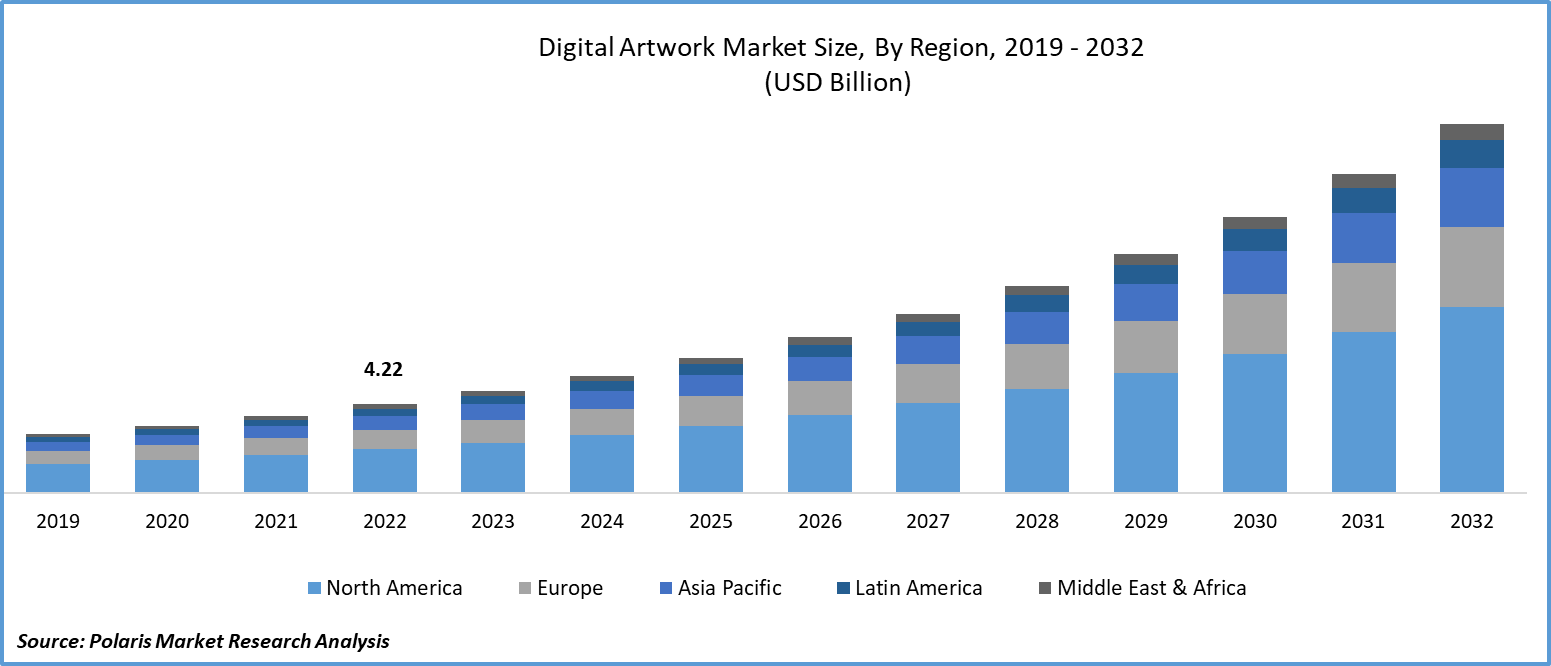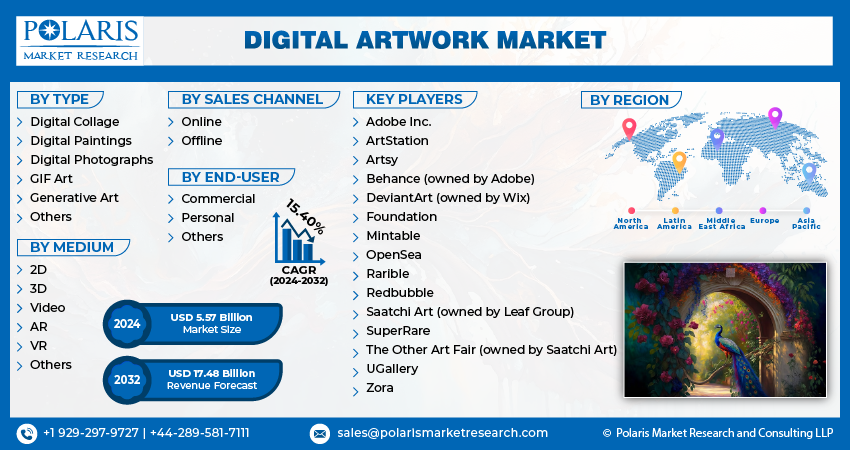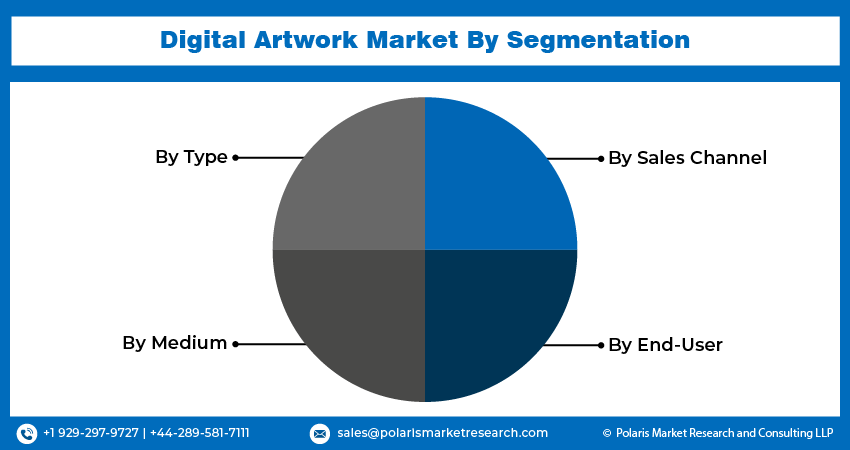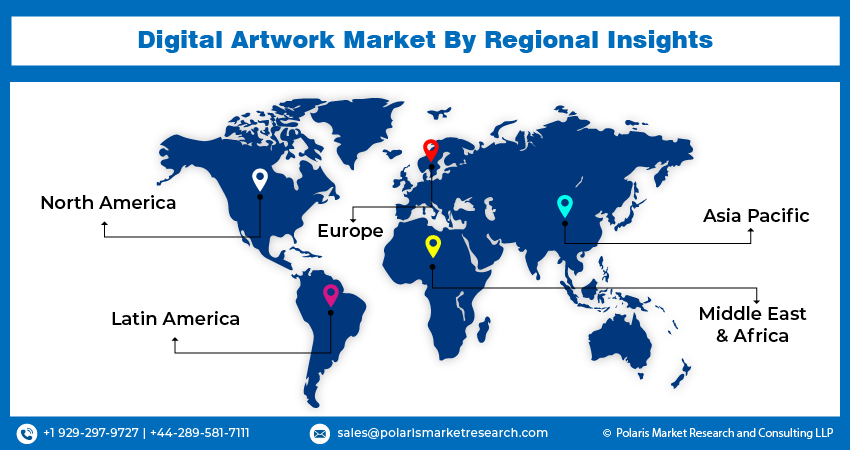
Digital Artwork Market Share, Size, Trends, Industry Analysis Report, By Type (Digital Collage, Digital Paintings, Digital Photographs, GIF Art, Generative Art, Others); By Medium; By Sales Channel; By End-User; By Region; Segment Forecast, 2024 - 2032
- Published Date:Jan-2024
- Pages: 116
- Format: PDF
- Report ID: PM4043
- Base Year: 2023
- Historical Data: 2019-2022
Report Outlook
The global digital artwork market was valued at USD 4.85 billion in 2023 and is expected to grow at a CAGR of 15.40% during the forecast period.
The digital artwork market exemplifies the harmonious interplay between technology and artistic ingenuity. In an age marked by digital revolution, artists wield digital tools to craft a wide array of visually captivating and technologically immersive creations. This market embraces an extensive range of creative endeavors, extending from 2D illustrations to immersive virtual reality experiences, propelled by progress in software, hardware, and the widespread accessibility of online platforms.

To Understand More About this Research: Request a Free Sample Report
The incorporation of AR and VR technologies has propelled digital art into a realm beyond traditional screens, ushering in an era of truly immersive experiences. AR enables the overlay of digital artworks onto the physical world, offering viewers an interactive encounter with art in their immediate surroundings. VR, on the other hand, immerses users in entirely virtual art spaces, transcending traditional notions of artistic presentation. This shift towards immersive experiences has expanded the creative possibilities for artists, unlocking uncharted territories of sensory engagement.
- For instance, in May 2023, Art de Finance, a pioneer in constructing a blockchain-powered Digital Renaissance art framework, forged a strategic alliance with Beosin, a leading blockchain security firm. This collaboration aims to propel the development of a secure Web 3.0 Art ecosystem, setting forth stringent security benchmarks for the art sector through the innovative q blockchain. Together, they seek to fortify the foundations of a trusted and resilient digital art landscape.
However, digital piracy and copyright protection are factors hampering the growth of the digital artwork market. The ethereal quality of digital art gives rise to apprehensions regarding unauthorized replication and dissemination. Both artists and platforms wrestle with safeguarding intellectual property rights in the digital domain, emphasizing the imperative need for robust methods of copyright enforcement.

Despite the increased availability of digital tools, there persists a requirement for user-friendly and cost-effective technologies to guarantee broad engagement in the process of creating digital art. Closing the technological gap is pivotal in cultivating an all-encompassing and varied community of digital creators.
Growth Drivers
- The increasing popularity of digital platforms is projected to spur product demand.
The advent of digital art has democratized the creative process, shattering traditional barriers that once limited artistic expression to a select few. Accessible digital tools and platforms empower artists of all backgrounds to channel their imaginative energies, revolutionizing the art-making process. This inclusivity has led to a flourishing community of digital creators, spanning from seasoned professionals to emerging talents.
Non-fungible tokens (NFTs) have emerged as a revolutionary force within the digital artwork market. These unique digital certificates, secured by blockchain technology, authenticate ownership of a specific piece of digital art. NFTs have redefined ownership and monetization in the digital realm, enabling artists to tokenize their creations and participate in an entirely new economic model. This development has triggered a paradigm shift, creating a direct link between the value of digital art and its scarcity and provenance.
Report Segmentation
The market is primarily segmented based on type, medium, sales channel, end-user, and region.
|
By Type |
By Medium |
By Sales Channel |
By End-User |
By Region |
|
|
|
|
|
To Understand the Scope of this Report: Speak to Analyst
By Type Analysis
- The Digital Paintings segment is expected to witness the highest growth during the forecast period.
The digital paintings segment is projected to grow at the highest CAGR during the projected period, mainly driven by the surge in the evolving landscape of artistic expression, where digital tools and techniques have gained prominence. Digital paintings offer artists a versatile canvas to explore boundless creative possibilities, from hyper-realistic renderings to abstract and conceptual art.
Additionally, the accessibility and affordability of digital painting software and hardware have democratized the medium, enabling a wider pool of artists to delve into this form of expression. The ability to easily edit, manipulate, and experiment with various styles and techniques has further fueled the popularity of digital paintings.
Moreover, the rise of NFTs has provided a platform for digital painters to tokenize and monetize their creations, opening up new avenues for revenue and recognition. As technology continues to advance, the digital paintings segment is poised for sustained growth and innovation within the digital artwork market.
By Medium Analysis
- Augmented Reality (AR) segment accounted for the largest market share in 2022
The Augmented Reality (AR) segment in the digital artwork market has experienced rapid expansion in recent years. AR technology overlays digital elements in the real world, creating interactive and immersive experiences. Artists are leveraging AR to blur the lines between physical and digital art, offering viewers a dynamic and engaging encounter. Museums and galleries are increasingly incorporating AR-enhanced exhibits, enhancing the visitor experience.
Moreover, AR-powered art applications allow users to interact with art in their environments, democratizing access to cultural experiences. The commercial sector has also embraced AR art, with brands using it for marketing campaigns and product displays. As AR technology continues to advance and become more accessible through smartphones and AR glasses, the segment is poised for sustained growth, revolutionizing the way art is experienced and consumed in the digital era.
By Sales Channel Analysis
- The online segment is expected to witness the highest growth during the forecast period.
The online segment is projected to grow at the highest CAGR during the projected period. Digital art platforms, marketplaces, and galleries have flourished, providing artists with a virtual stage to showcase and sell their creations to a vast online audience. This surge in online engagement has democratized access to art, allowing enthusiasts and collectors from around the world to explore and acquire digital artworks.
Additionally, the rise of NFTs has further catalyzed this growth, revolutionizing the way digital art is bought and sold. With continuous technological advancements and increasing digital connectivity, the online segment is poised for continued expansion in the digital artwork market.
By End-User Analysis
- The commercial segment held a significant market revenue share in 2022
The Commercial segment within the digital artwork market is experiencing notable growth as businesses recognize the potential of digital art in marketing and branding. Digital art is increasingly integrated into advertising, product design, and multimedia campaigns, enhancing engagement and customer experiences. It offers a fresh and innovative way to connect with audiences, making commercial applications more dynamic and captivating. The advent of NFTs has also allowed brands to explore unique collaborations with digital artists, creating exclusive and collectible content for their audiences. This trend is expected to continue expanding as companies harness the creative power of digital art to stand out in the competitive commercial landscape.

Regional Insights
- North America region dominated the global market in 2022
The North American region dominated the global market with the largest market share in 2022 and is expected to maintain its dominance over the anticipated period. The growth of the segment market can be largely attributed due to technological advancements and a strong artistic community; the region has embraced digital art across various forms. With the rise of NFTs, North America has played a leading role in pioneering the tokenization and monetization of digital creations.
The Asia-Pacific region is expected to be the fastest-growing region during the forecast period. The digital artwork market in Asia-Pacific is rapidly evolving, reflecting the region's dynamic blend of tradition and technology. With a surge in digital innovation and a rich cultural heritage, Asia-Pacific has become a melting pot of artistic experimentation. The growing tech-savvy population, digital art collaborations, and the exploration of augmented and virtual reality experiences fuel the market. Additionally, the rise of NFTs has garnered considerable attention, with artists and collectors actively participating. As the region continues to embrace digital art as a medium for creative expression and investment, the Asia-Pacific digital artwork market is poised for substantial growth and transformative artistic exploration.

Key Market Players & Competitive Insights
The digital artwork market is fragmented and is anticipated to witness competition due to several players' presence. Major service providers in the market are constantly upgrading their technologies to stay ahead of the competition and to ensure efficiency, integrity, and safety. These players focus on partnership, product upgrades, and collaboration to gain a competitive edge over their peers and capture a significant market share.
Some of the major players operating in the global market include:
- Adobe Inc.
- ArtStation
- Artsy
- Behance (owned by Adobe)
- DeviantArt (owned by Wix)
- Foundation
- Mintable
- OpenSea
- Rarible
- Redbubble
- Saatchi Art (owned by Leaf Group)
- SuperRare
- The Other Art Fair (owned by Saatchi Art)
- UGallery
- Zora
Recent Developments
- In August 2023, Adidas Studio, also known as Three Stripes Studio, revealed its worldwide introduction of a digital artist residency initiative named "Residency by Adidas" on Thursday. This program by the renowned streetwear brand will shine a spotlight on artists from around the world
Digital Artwork Market Report Scope
|
Report Attributes |
Details |
|
Market size value in 2024 |
USD 5.57 billion |
|
Revenue Forecast in 2032 |
USD 17.48 billion |
|
CAGR |
15.40% from 2024 – 2032 |
|
Base year |
2023 |
|
Historical data |
2019 – 2022 |
|
Forecast period |
2024 – 2032 |
|
Quantitative units |
Revenue in USD billion and CAGR from 2024 to 2032 |
|
Segments Covered |
By Type, By Medium, By Sales Channel, By End-User, By Region |
|
Regional scope |
North America, Europe, Asia Pacific, Latin America; Middle East & Africa |
|
Customization |
Report customization as per your requirements with respect to countries, regions, and segmentation. |
